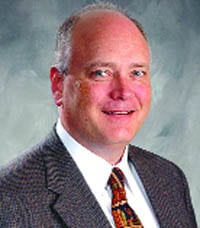Making a Connection Match Day Brings Hospitals, Medical Students Together
“Mike the medical student was so ready to start his career…”
“How ready was he?”
“He was so ready, he asked to serve his residency at … blank.”
OK, so it’s hardly a game, and Gene Rayburn was nowhere to be found. But the recent Match Day was still a source of great excitement — and anxiety — for the thousands of medical students who discovered where they will conduct their residency training on their paths to careers as doctors.
“Match Day is when graduating medical-school seniors find out where they’re going for their residency training programs. It’s the culmination of all their interviews during the year — and they all find out on the same day,” said Dr. Hal Jenson, chief academic officer of Baystate Medical Center.
To begin the matching process, candidates apply to residency programs through an electronic application service, Jenson explained. After conducting a series of in-person interviews, they rank, in order, the programs at which they are interested in training, while the hospitals rank the candidates they would like to take on. A computer algorithm then matches the programs and applicants based on their mutual preferences.
“People are matched to the highest preference where they’ve been accepted,” said Jenson. “Typically a program will rank more than 100 people, and most candidates will rank about 10 to 20 programs.”
Baystate Medical Center was one of more than 4,000 residency programs nationwide participating in Match Day, which fell on March 20 this year.
Nationally, Match Day drew the largest number of applicants ever, with 28,737 seniors vying for 22,240 first-year residency positions, according to the National Resident Matching Program (NRMP), which oversees the program. They included a record 15,242 applicants from U.S. medical schools, 94.2{06cf2b9696b159f874511d23dbc893eb1ac83014175ed30550cfff22781411e5} of whom were successfully matched to a program — with 84.6{06cf2b9696b159f874511d23dbc893eb1ac83014175ed30550cfff22781411e5} matching to one of their top three program choices.
In a statement, NRMP President Dr. Henry Schultz called the 2008 match “a remarkable success.” In addition, the number of first-year residency positions available through the match was also the highest in history, with 395 positions added this year.
Rising Interest
Match results can be an indicator of career interests among graduating medical school students. More than 20{06cf2b9696b159f874511d23dbc893eb1ac83014175ed30550cfff22781411e5} of the positions available through the match this year were in internal medicine, and 2,660 U.S. medical school seniors (17.4{06cf2b9696b159f874511d23dbc893eb1ac83014175ed30550cfff22781411e5} of all those participating) matched to one of those positions.
One notable trend in specialty choice this year was an increased interest in family medicine residency positions; 1,156 (or 7.6{06cf2b9696b159f874511d23dbc893eb1ac83014175ed30550cfff22781411e5}) of seniors matched to one of those positions, up from 7.2{06cf2b9696b159f874511d23dbc893eb1ac83014175ed30550cfff22781411e5} last year. More importantly, there were more family medicine positions offered through the match this year, reversing what had been a significant decline in available positions since 1998. The 2008 match results also indicate that plastic surgery, orthopedic surgery, dermatology, otolaryngology, diagnostic radiology, radiation oncology, and general surgery continue to be popular and competitive specialties.
Separate from Match Day, the NRMP also conducts matches for fellowship positions in 34 subspecialties — such as pediatric cardiology, allergy/immunology, and vascular surgery — through its Specialties Matching Service. Those positions involve further training after completion of the initial residency program and lead to certification in a specialty, and the matches are arranged throughout the year.
In any case, said Jenson, the decision of the computer is final. “When you sign the match agreement at the start, you’re obligated to honor the match,” he explained. “If there’s a personal emergency or medical condition that would keep you from fulfilling a match, you have to get a waiver.”
Furthermore, he said, U.S. medical students are required to take part in Match Day, although only some applicants from outside the U.S. take part, while others find positions outside the match system. Every hospital that has a graduate medical-education program, such as Baystate, takes part in the match program, he said, and for good reasons.
“It provides both the applicants and the programs the opportunity to interview and consider multiple choices before making a decision, and in making the matches, it provides a unique service,” he said. “Otherwise, it would be chaotic.”
There is an element of chaos to the process for those applicants who are not matched to a residency position. They immediately participate in what is known as the “scramble.” The day after the matches are revealed, the locations of remaining unfilled residency positions are released to unmatched applicants, who then have the opportunity to contact the programs directly to express interest in the open positions.
Following Match Day this past March, there were 1,300 unfilled first-year residency positions available for participants in the scramble. The NRMP estimates that between 12,000 and 13,000 people attempted to secure one of those open positions. Among these residency-seekers are the 7,800 applicants who did not match to a program (883 of whom are U.S. medical school seniors), as well as approximately 5,000 additional individuals who registered for the match but did not complete all of the steps required for participation.
School of Thought
Overall, however, the NRMP claims, Match Day accomplishes what it was intended to when the process was started back in 1952: to organize a fair, impartial, and organized transition from medical school to residency.
“The record size of the match this year and the favorable outcome for students,” Schultz said, “are certainly reasons to celebrate this important rite of passage along the path to becoming a doctor.”

